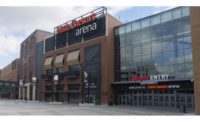School District Addition Meets Energy and Aesthetic Goals with Masonry System

Just 60 miles northwest of Chicago, the Illinois terrain turns dramatically rural with farms and open grassy spaces speckling the landscape. Located in the southwest corner of McHenry County, the Riley Consolidated School District campus is home to approximately 300 K-8 students. Originally built in the 1940s and a 1950 addition, updates to the school have been few and far between with the 1975-era gymnasium serving as an all-purpose venue for decades.
Until recently, band and choir classes operated out of portable classrooms, and the aging cafeteria/kitchen was in the basement level of the original building with no restrooms. By spring of 2022 it was time for an update to this vintage structure.
Usha Sundaram, AIA, with U.S. Architects P.C., was the lead architect on the project. She explained some of the goals and challenges encountered during the planning stages.
“We were dealing with a very old school with no wall cavities in 4-inch brick and block,” she noted. “The site was very tight with existing buildings on the north and west, a septic field on the east and a septic tank on the south. Along with band and choir rooms, we thought it better to move the cafeteria and kitchen to the new building with updated facilities.”
Sundaram had discovered Echelon’s InsulTech Masonry System while attending an AIA conference in 2017 and chose it as the primary building material for the extension. The product was supplied by Rockford Cement Products.
Sundaram recalled, “The presentation that I attended featured building designs with a combination of the block with brick, and I had been looking for a place to use it ever since; it was an ideal choice for the Riley addition.”
InsulTech’s all-in-one, pre-assembled structural masonry units gave Sundaram the architectural flexibility needed for this project. The system was engineered with five components—structural CMU, Neopor GPS insulation, air barrier, moisture management drainage channels, and non-structural veneer face—in a single, preassembled 14 ¼” unit (10” structural CMU backup).
“With only 72,000 square feet to work within, we needed the wall to be as thin as possible,” the architect remarked. “We ruled out precast concrete since it would not be cost effective for this size building, and the interior walls would have had to be furred out for running wiring and piping, reducing the usable area. Traditional cavity walls measure 19 inches versus InsulTech’s 14-inch walls—we saved 5 inches and 150 square feet of usable area in a space where every inch counts.”
Along with its space saving properties, InsulTech’s system’s design improved efficiency on the job site. The pre-assembled blocks eliminated the multiple passes that would have been necessary to construct standard cavity walls.
“Budget was a big consideration,” said Sundaram, “and we saved costs on installation time by using InsulTech. We were able to get the modern look by using full height block at the addition, and then broke up the pattern by adding some center-scored blocks and accent color in the middle without incurring additional expenses.”
Although the budget was too tight for LEED certifications, Sundaram relies on masonry for lifecycle and sustainable benefits. “The future of our kids depends on green practices that use masonry and other materials,” she said.
To meet the current International Energy Conservation Code (IECC) and save on the school’s energy costs, the project required a top performing thermal insulation material. InsulTech’s patented design utilizes BASF Neopor GPS molded inserts resulting in an assembled unit with an effective R-Value of 16.0 at 75° F, meeting IECC requirements in Zones 1-7.
Sundaram and her team needed to qualify for the ComEd energy rebate for the school and achieved the needed R-Value of 16.0 based on the 2021 ICC code. For soundproofing and noise control, we used acoustical wall panels, suspended acoustic panel luminaire, acoustical roof deck and exterior InsulTech masonry system.
“We used KalWall translucent insulated wall panels for window openings that let in the light, yet are energy efficient,” she said. It provides privacy and daylight and ties with the existing building.”
InsulTech’s internal stainless-steel metal anchors molded into GPS inserts ensured a strong connection to the structural wall, providing wind-load resistance and Fire Integrity™ for fire safety. This was a bonus feature for the school since the cafeteria will double as a tornado shelter.
Chris Janic of Burroak Masonry (BMI), a Leland, Illinois-based firm, worked with Echelon’s Len Browning to get up to speed on the new material. Onsite training support and projects visits were also provided by Len Browning of Oldcastle APG and Christina Meck of APG’s Northfield Block.
“As promised, these Oldcastle team members were on-site to provide training for our block layers,” said Janic. “After a sample panel was built, we had Usha come out for review. She had a few questions answered by the team and the next day we started building up the walls. The job went very well for our company and we are very proud of the final product.”
Sundaram said, “Burroak Masonry did a terrific job and it worked beautifully. With the pre-assembled, factory finished units and careful design (3D) with nominal masonry dimensions, they didn’t have to cut any block, saving on labor and installation time. We used 5,956 square feet of basic InsulTech blocks with Harvard Brick finish veneers—a good natural product with an excellent lifecycle. Using CADBLOX-generated shop drawings helped us order the precise number of blocks needed leading to minimum or zero waste.”
With both the structural block and exterior veneer available in both standard finishes and Harvard Brick, Sundaram selected a finish that would complement the existing exterior.
“With plenty of Harvard Brik color choices, we were able to complement the existing building color scheme,” she said. “We chose Mesaba Tide as the field color and Pebble Beach for the accent color.” She was pleased that both complemented the existing brick shades from the 1948 original building and the 1975 addition. “We created an interesting pattern without breaking the bank to achieve a 21st century modern look for the addition while tying it to the original building.”
This product really works even for a smaller scoped project! “The bids came in within the budget,” she said. “The original bid $2.22M and the final with change orders was $2.28M.” Sundaram noted that $415,000 of the total budget was for masonry.
The school welcomed students back in the fall of 2023, and the reaction to the new addition was overwhelmingly positive. “The school administrators were exceptionally pleased with the outcome as we were. It has a nicer aesthetic than they thought possible—all brought in on time and right on budget. We chose the InsulTech system to save time and money, gain additional square footage, and conserve energy, and we did not spend extra to make it look great. It all worked beautifully, and I would undoubtedly use the InsulTech Masonry System for other projects.” Learn more about Echelon Masonry and insulTech at www.EchelonMasonry.com
Looking for a reprint of this article?
From high-res PDFs to custom plaques, order your copy today!





